This Strawberry Shortcake recipe is a classic dessert made with a simple homemade moist and fluffy shortcake, sliced macerated strawberries, and whipped cream.
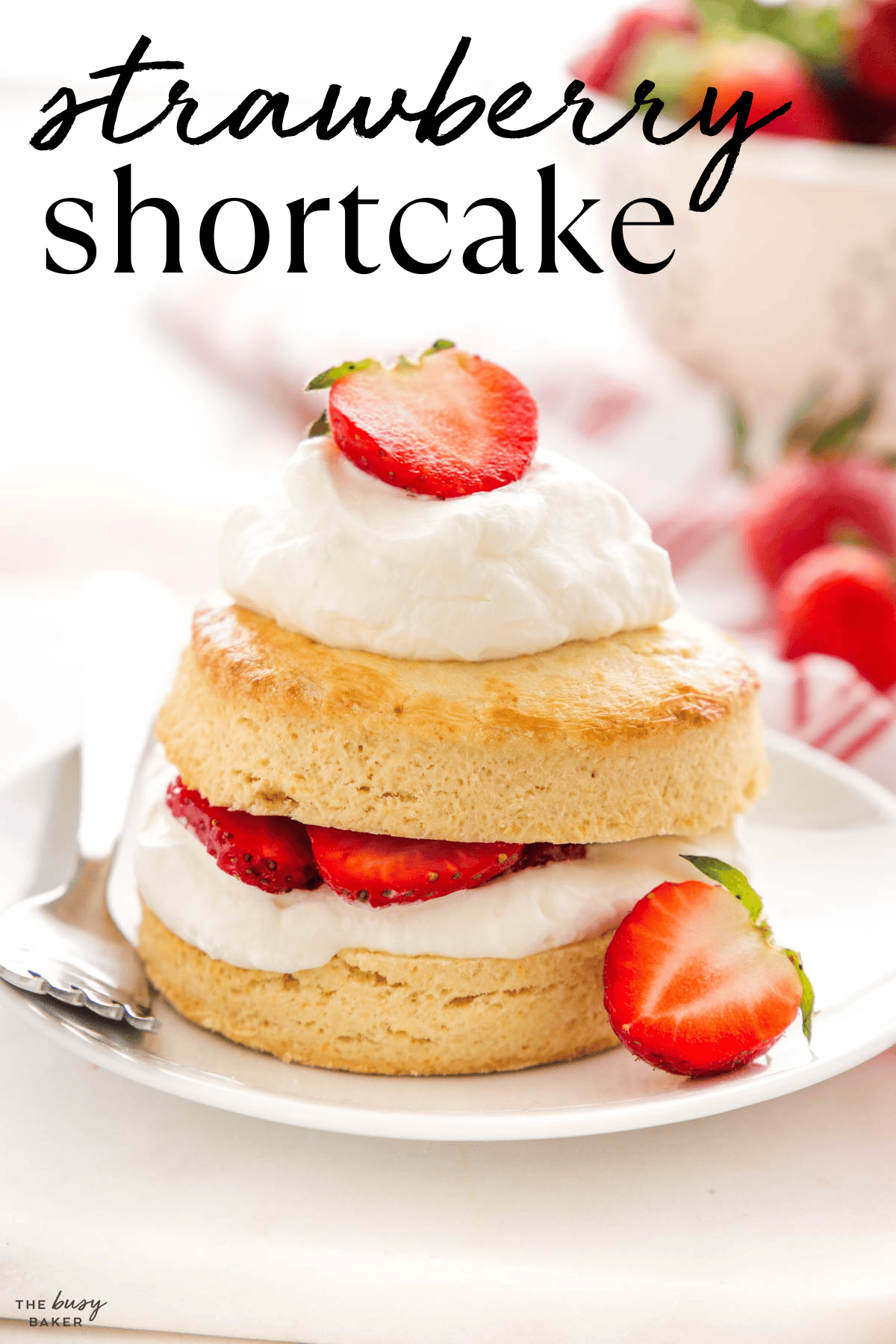
Estimated reading time: 1 minute
There’s no dessert more classic than a good old strawberry shortcake. We absolutely love strawberry everything, and this Strawberry Shortcake recipe is one of our absolute favourite ways to enjoy fresh strawberries during strawberry season. If you’re hosting a tea party, a baby or wedding shower, or you’re just looking for a simple make-ahead dessert, we’ve got you covered with this Strawberry Shortcake recipe. Trust us, you’re going to love it!

Strawberry shortcake is popular dessert that combines fresh, sweet strawberries with tender, fluffy shortcake, and sweetened whipped cream. It’s a classic sweet treat that resembles a scone-like cake that is split horizontally and filled with sliced strawberries that have been macerated in sugar. The strawberries release their natural juices, creating a delicious syrupy sauce that soaks into the cake. It’s served with a generous dollop (or two!) of softly whipped cream, creating a dessert that’s as beautiful as it is delicious!
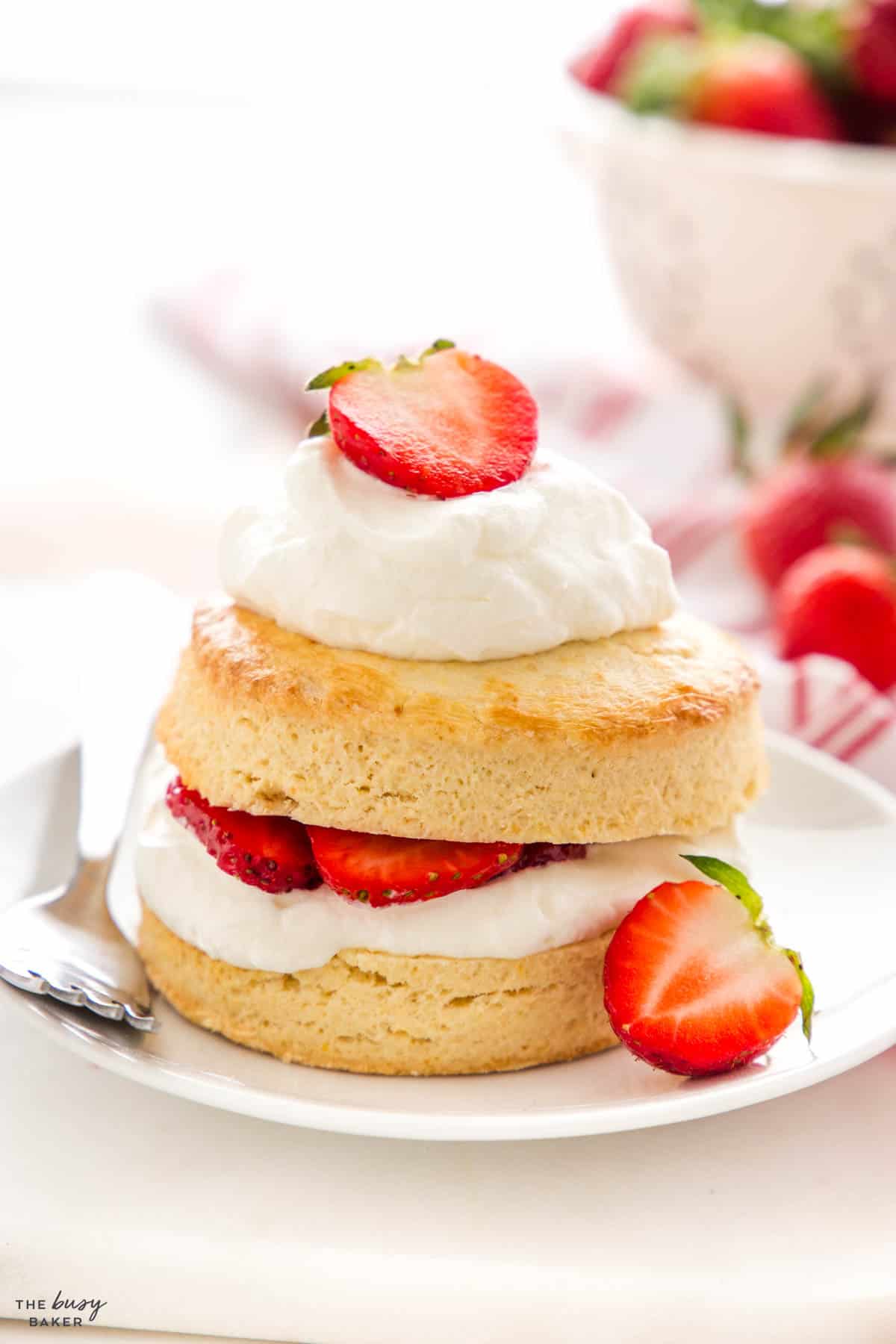
Shortcake is a rich, flaky cake made with flour, sugar, butter, and baking powder. Despite its name, a shortcake recipe is not very similar to a traditional cake recipe – it has a very different texture than a typical cake and instead, it actually resembles a soft and moist scone. The term “short” in the word shortcake refers to the high amount of fat (real unsalted butter) that’s cut into the flour, giving the cake its characteristic fluffy, flaky texture. Shortcake dough is mixed until just combined, folded, and cut into rounds for individual servings. It’s brushed with cream, baked, and then served with juicy strawberries and soft whipped cream.
While traditional cakes are made with a higher proportion of liquid, making them softer and more pillowy, a shortcake recipe calls for a higher proportion of fat and less liquid. This inhibits gluten formation and keeps the texture more dense and flaky. The leavening in shortcake comes mostly from baking powder, which provides just enough lift to create a tender texture but not the sponge-like fluffiness of traditional cakes. Shortcake doesn’t get soggy and soak up liquid like a traditional cake does, making it perfect for serving with fresh berries.
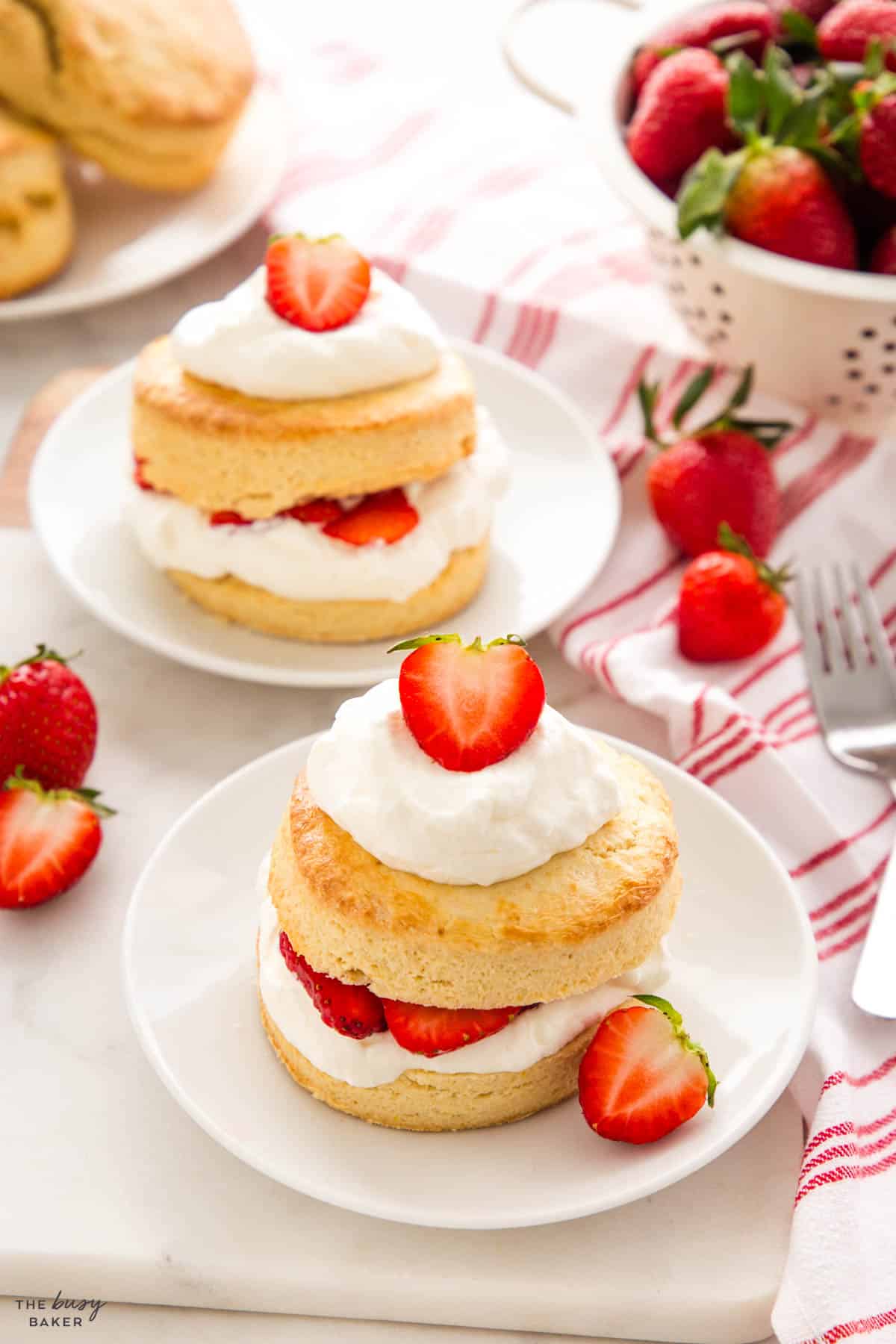
Want to make this BEST EVER tender, fluffy homemade strawberry shortcake recipe? Here’s how to do it!
Cold butter straight from the fridge is what helps create those flaky layers and that soft texture. Using warm or room temperature butter will cause your dough to be too liquid-y and you’ll end up with a mushy mess and dense, heavy shortcakes. When the butter is cold the fat remains solid, which is what creates those flaky layers.
In our experience, the BEST way to combine the dry ingredients and the butter is with your hands, using quick rubbing motions. Pick up a handful and rub it once between your hands to create small sheets of butter instead of tiny clumps. This will help create those flaky layers instead of big pockets of air.
Don’t over-mix or over-work the dough. Nobody likes a tough, dry strawberry shortcake, and this is what over-mixing the dough will create because mixing activates the gluten in the flour. Mix just until the flour almost disappears and you’ll be left with flaky layers and a nice, tender shortcake!
When the dough is just about mixed (when you still see streaks of flour), pour it out onto a lightly floured work surface and fold it in half, and in half again (and again) until everything is combined. This will also create delicious layers and prevent the dough from becoming dry.
Pat the dough out to a thickness of about 1-2 inches. Thinner dough won’t rise as well and you’ll end up with shortcakes that are flat and less flaky.
When cutting out your shortcakes, use a sharp, straight-edged cutter to press down directly through the dough. Some recipes recommend using a glass, but we’ve found that when you use a dull-edged cutter or when you use a sharp cutter and twist the cutter it can seal the edges of the shortcake and prevent it from rising properly.
To give your shortcakes a professional bakery look, lightly brush the tops with some cream before baking. This will help the tops stay shiny turn a delicate golden brown.
Space the shortcakes about 2 to 3 inches apart on the baking sheet to allow for even cooking and proper heat distribution as they bake.
Make sure your oven is properly preheated to a higher temperature (375 Fahrenheit) so when the dough hits the heat of the oven they’ll rise quickly and form a crisp outer shell that will help to lift the shortcakes as they bake.
Slicing the strawberries, tossing them with sugar and letting them develop their own juicy sauce takes this recipe over the top. Don’t skip this step!
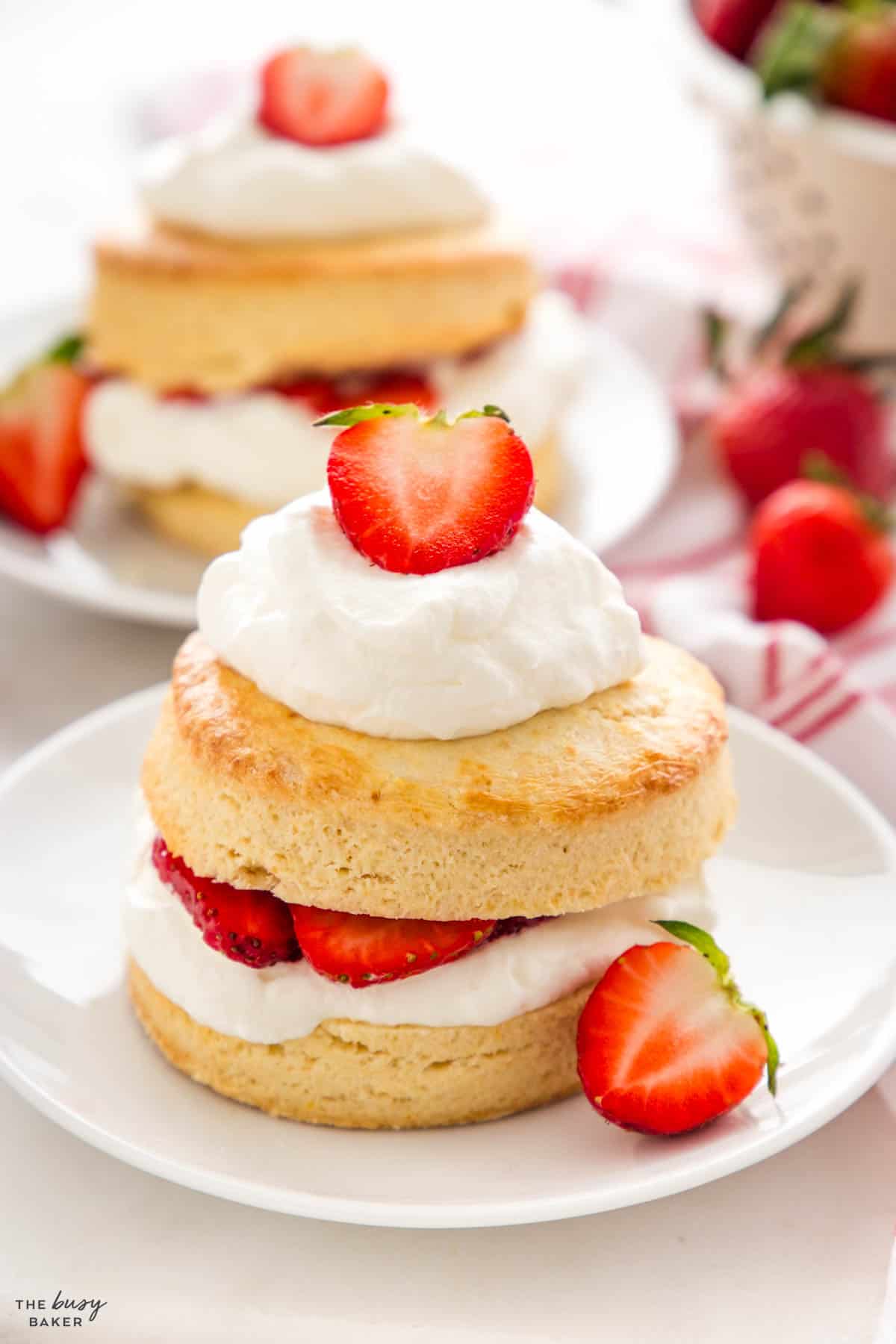
The key to baking up perfect shortcake is in the science of how the ingredients, especially the butter, are incorporated into the dough. The texture of the final result depends on how the butter interacts with the flour before and during baking. When cold fat, like butter, is mixed with flour and then heated in the oven, it melts and releases steam. It’s this steam that helps to create layers and thin pockets within the dough, giving it lift and flakiness.
Here are the four most common methods to incorporate butter into the flour mixture when making a strawberry shortcake recipe:
- Sheeting Butter by Hand: This is our favourite technique when it comes to making scones, biscuits, and shortcake. It involves flattening chunks of cold butter directly into the flour mix using the palms of your hands. Pick up a handful of the mixture and rub it once between your hands to create small sheets of butter instead of tiny clumps. This method allows the butter to remain in larger, flatter pieces within the flour, which melt during baking to create pockets of steam that give the shortcakes flakiness.
- Grating Frozen Butter: An alternative and almost as effective method is to grate frozen butter into the flour mixture using a box grater. This technique distributes the butter more evenly throughout the flour, which can promote a uniform texture and consistent flakiness throughout the shortcake. But since the butter flakes are smaller, the shortcakes aren’t quite as fluffy and flaky as when you create sheets of butter by hand. After grating, quickly toss the butter shreds into the flour mixture to coat them before they begin to melt. This helps keep the mixture cold and delays the fat from integrating fully into the flour, ideal for achieving a light, airy texture.
- Using a Pastry Cutter: For those who prefer not to get their hands buttery, a pastry cutter or pastry blender offers a clean and efficient way to cut butter into the flour. This tool helps break the cold butter into small pebbles or coarse crumbs without warming it, which is crucial for flaky pastry. The key here is to avoid overworking the mixture; you’re aiming for a crumbly texture where some larger pieces of butter are still visible. These bits of butter will melt as the shortcakes bake, creating similar pockets of steam. With this method, the shortcakes are fluffy but less flaky since the butter pieces are in chunks, not sheets.
- Using a Food Processor. We hate washing extra dishes so this method isn’t our first choice, but the butter and dry ingredients can be added to a food processor and pulsed until the mixture resembles coarse crumbs. This method works in a similar way to using a pastry cutter and it results in a fluffy shortcake without the same flakiness as the first two methods because the butter pieces are in chunks, not sheets.
Each method has its benefits, and choosing one over the other can depend on personal preference or the specific texture you’re aiming for in your homemade shortcake. We always choose the first method, sheeting the butter by hand, because in our experience it yields the best, most professional results.
Regardless of the method you choose, the main principle remains: the butter must stay as cold as possible while being integrated into the flour to prevent it from blending too thoroughly into the flour before baking. This ensures that during baking the butter melts and creates steam and lift, resulting in light, flaky, and tender shortcakes.
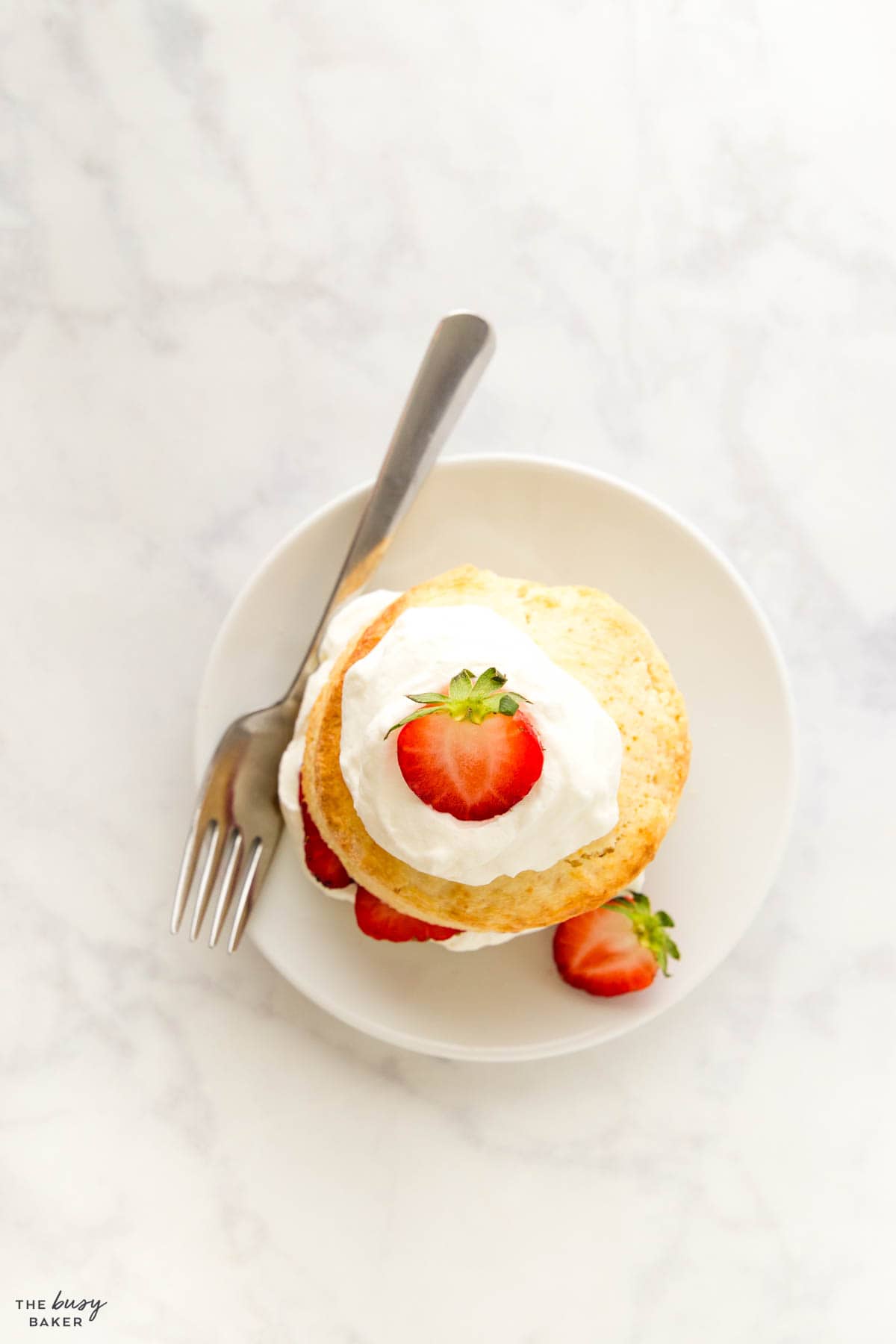
Here’s the kitchen equipment you’ll need to have on hand to make this strawberry shortcake recipe (paid links):
- mixing bowls
- measuring cups and spoons
- liquid measuring cups
- Whisk
- silicone or rubber Spatula
- Baking Sheets and Parchment Paper for baking the shortcakes
- a chopping board and knife for slicing the strawberries
- a Hand Electric Mixer or Stand Mixer for whipping the cream
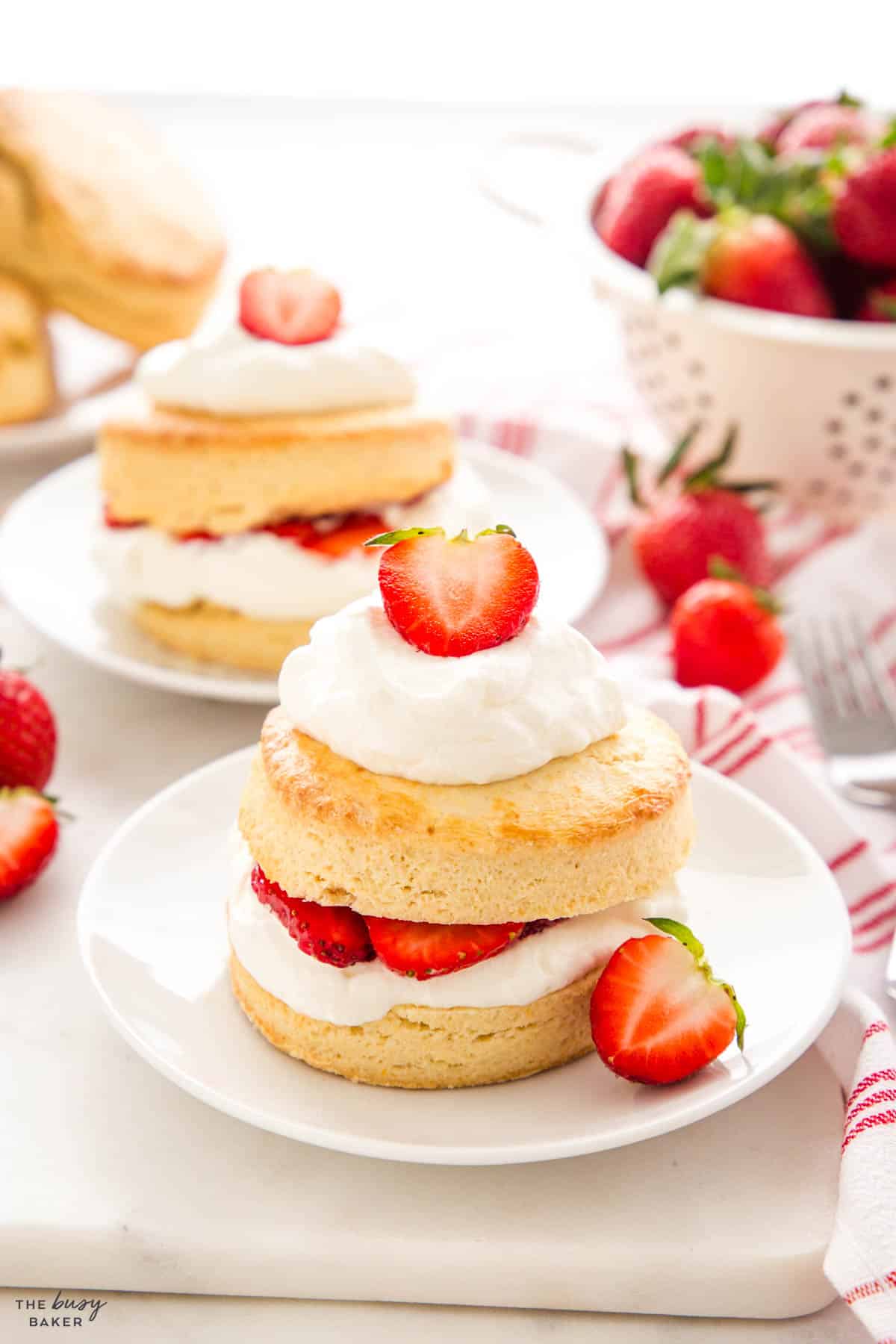
Here’s a list of the ingredients you’ll need to make this Strawberry Shortcake recipe (paid links):
For the Shortcakes
- 3 cups all purpose flour
- 1/3 cup granulated sugar
- 1 tablespoon baking powder
- 1/4 teaspoon salt
- 1/2 lemon zest only
- 3/4 cup half and half cream plus a few extra tablespoons for brushing on the shortcakes before baking
- 1 large egg
- 1 teaspoon vanilla extract
- 1/2 cup unsalted butter cold from the fridge
For the Strawberries
- 4 cups fresh strawberries sliced
- 4 tablespoons granulated sugar
For the Whipped Cream
- 2 cups heavy whipping cream
- 2 tablespoons granulated sugar
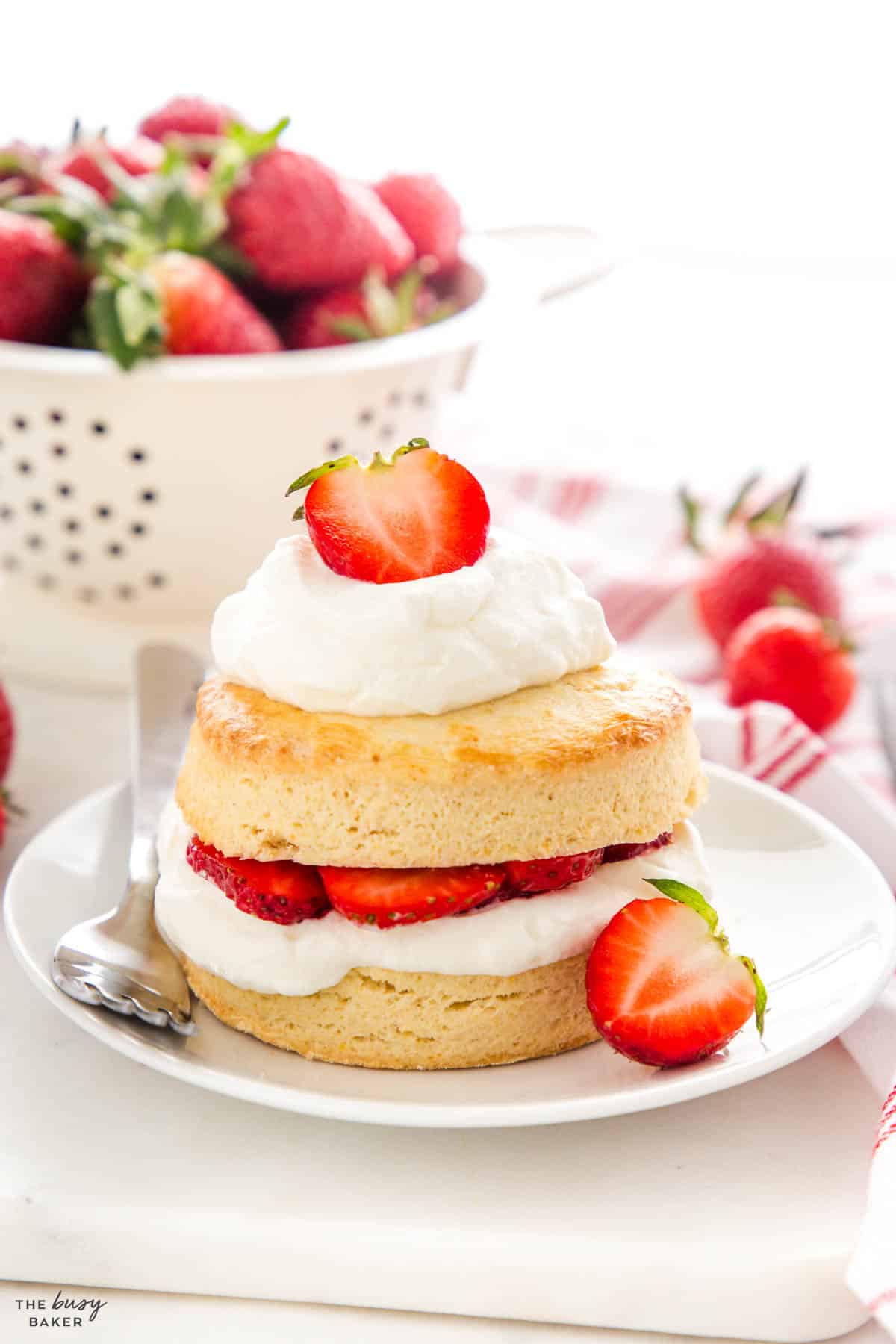
Want to try something new? Here’s a list of our favourite variations on this classic strawberry shortcake recipe!
- Strawberry Cheesecake: Fold some whipped cream cheese into the heavy cream as it whips for a cheesecake twist on the original.
- Blueberry: Serve with fresh blueberries instead of strawberries for a blueberry-forward dessert.
- Raspberry: Serve with fresh raspberries instead of strawberries for the perfect dessert for raspberry lovers!
- Cherry: Serve with chopped cherries instead of strawberries and replace the vanilla extract with almond extract in the shortcakes.
- Balsamic Strawberry: Drizzle balsamic reduction over the strawberries when macerating them. The balsamic vinegar enhances the sweetness of the strawberries and adds a rich depth of flavour.
- Peaches and Cream Shortcake: Replace strawberries with fresh peaches or a mix of peaches and strawberries. Peaches offer a sweet, juicy variation and go wonderfully with the cream and biscuit base.
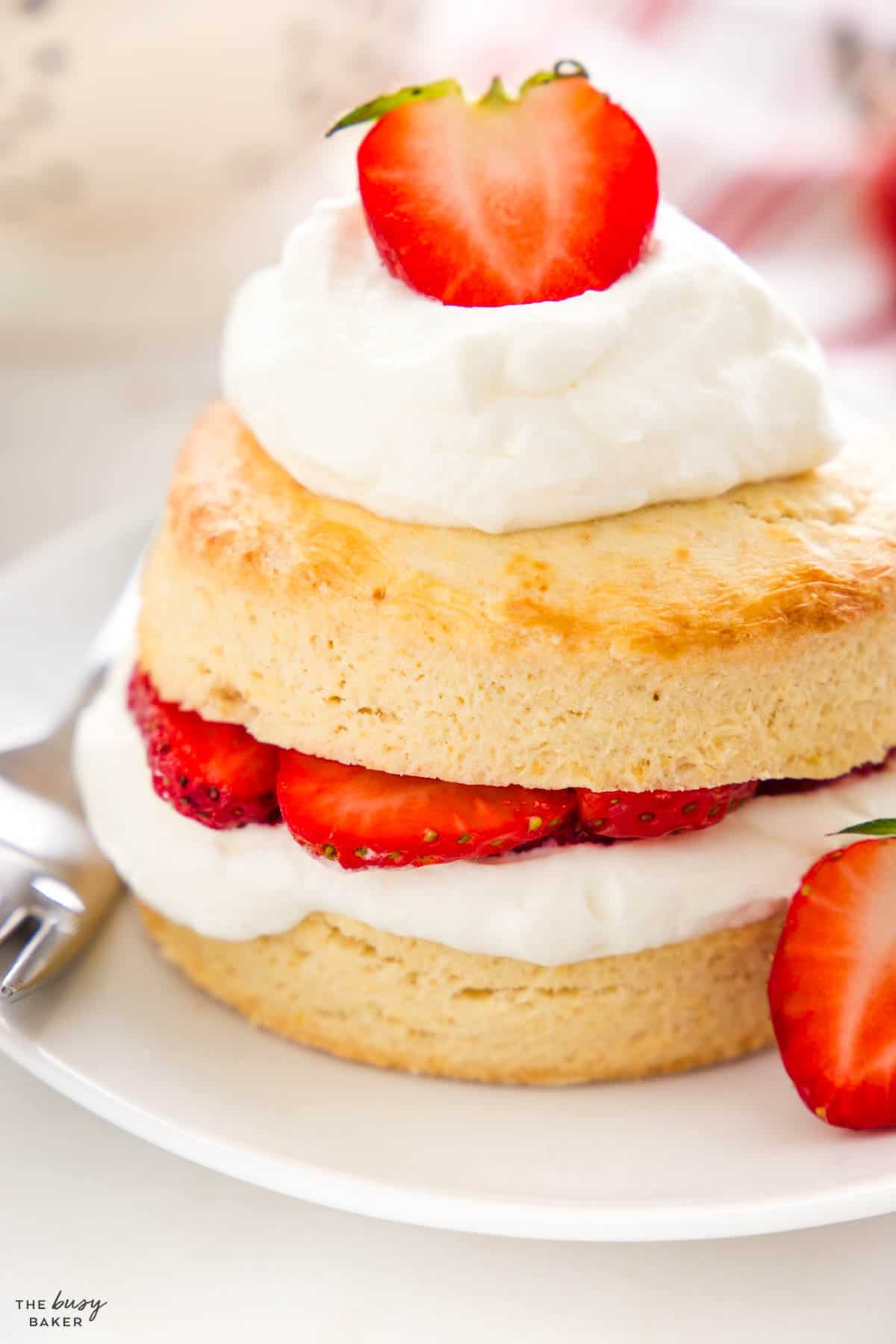
Time needed: 50 minutes
Follow these steps to make the perfect Strawberry Shortcakes recipe!
- Preheat your oven.
Preheat your oven to 375 degrees Fahrenheit and prepare a baking sheet or two (depending on how large your baking sheets are) by lining them with parchment paper. Set aside.
- Combine the dry ingredients.
In a large bowl combine the flour, sugar, baking powder, salt, and lemon zest. Mix well with a fork or a whisk.
- Combine the wet ingredients.
In a liquid measuring cup, measure the cream and add the egg and vanilla. Whisk together using a fork and set aside.
- Cut in the cold butter.
Cut up your butter, right from the fridge, into little pieces and dump it into the flour mixture. Using your hands (wash them well first and remove any rings), pick up handfuls of the butter and flour mixture, rubbing the pieces of butter and the flour between the heels of your hands to create “sheets” of butter.
- Combine everything together.
Pour in the wet ingredients and mix roughly with a fork. Do not over mix, or the result will be heavy and dense.
- Use your work surface.
Once the wet ingredients have been incorporated but there are still several streaks of flour, turn the dough out onto a clean and floured counter surface. Press the dough down into the counter and then fold one half over the other half, like you are folding a piece of paper. Press down again and make another fold. Repeat this 2 or 3 more times, gathering any outlying dough bits and flour into your folds.
- Shape the dough.
Once your dough is formed after folding several times, shape it into a rectangle about 1 3/4 to 2 inches thick (approximately). Again, be careful not to handle the dough too much, so a few little cracks here and there are fine.
- Cut the shortcakes.
Cut out circles of dough using a biscuit cutter or a sharp-edged rim of a glass or jar. Arrange the circles of dough on the parchment-lined baking sheet and brush the tops with a little bit of half and half cream.
- Bake to perfection.
Bake for about 18-22 minutes just until barely golden brown and the surface of the shortcakes lose their shine. Let them cool for 3-5 minutes on the baking sheet. Transfer them to a cooling rack to cool completely.
- Macerate the strawberries.
Add the sliced strawberries to a bowl and stir them together with the sugar. This will cause the strawberries to release moisture and create a sweet sauce.
- Whip the cream.
Whip the cream in the bowl of your stand mixer fitted with the whisk attachment or use a hand mixer and a mixing bowl. Add the sugar slowly when the cream begins to foam. Whip until the cream forms stiff peaks.
- Assemble and serve.
Once the shortcakes are baked and cooled, slice them in half and place a large dollop of cream between the layers, along with a spoonful of the strawberries and sauce. Add the top of the shortcake on top and add another dollop of cream and more strawberries. Serve immediately.
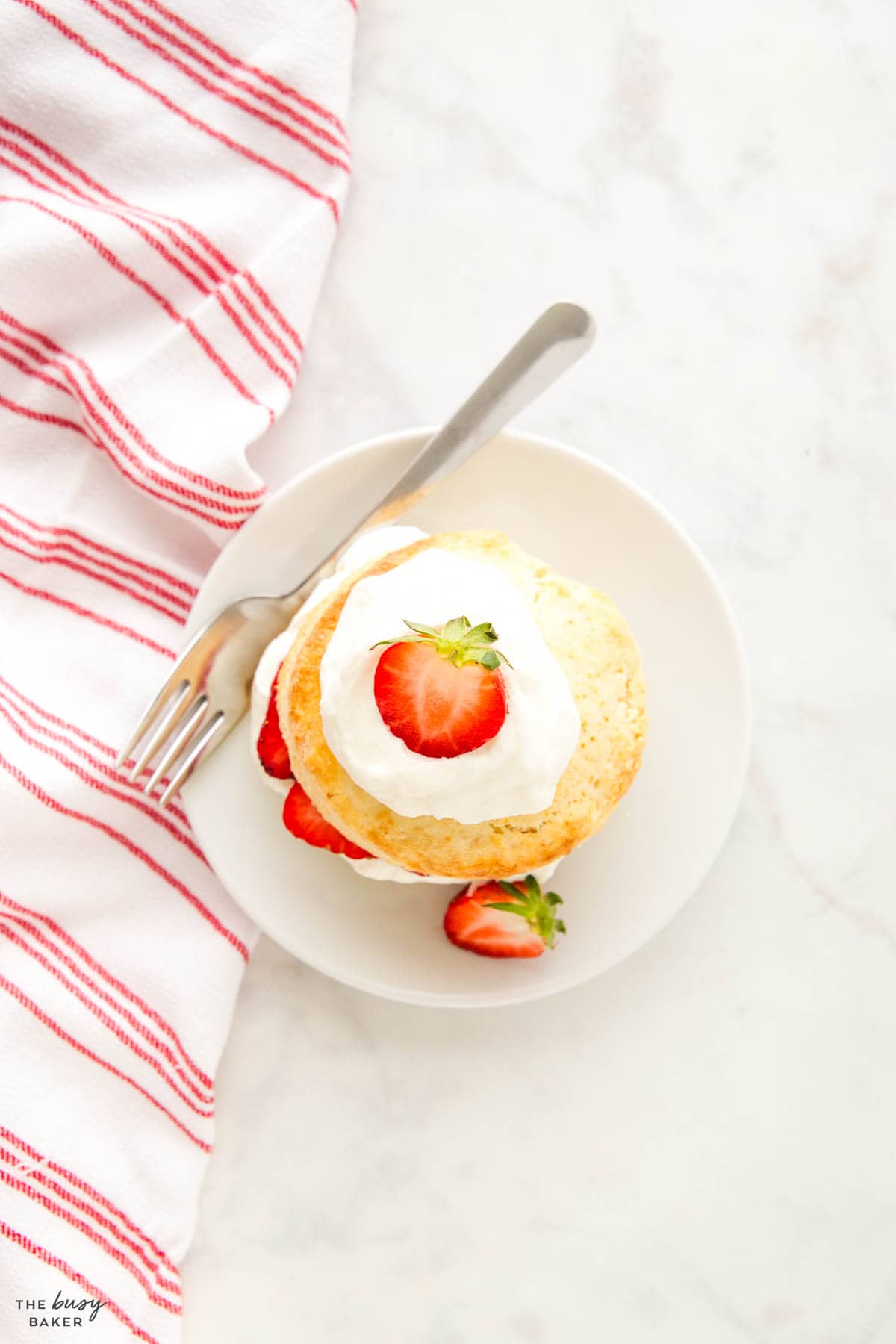
Can I use biscuit dough to make Strawberry Shortcake?
We don’t recommend using biscuit dough for this recipe as it’s not sweet enough and can often turn out tough and dry.
What is strawberry shortcake made of?
It’s made of a homemade flaky, fluffy scone-like cake topped with fresh strawberries and whipped cream.
What’s the difference between strawberry shortcake and regular cake?
Shortcake is a scone-like cake that has a more flaky, soft texture than traditional cake.
How much sugar does a strawberry shortcake have?
Strawberry shortcake is lower in sugar than many conventional cakes and desserts with only 24 grams of sugar per serving.
How can you make strawberries sweeter?
Macerating strawberries makes them very sweet. To macerate strawberries, slice them and add a little sugar, letting them sit and release their own juices.
How long does strawberry shortcake last?
It’s best enjoyed within 24 hours of baking, but shortcakes can be stored at room temperature for a few days. We recommend assembling them with the berries and cream right before serving.
How do I store strawberry shortcake?
Store any leftover shortcakes in an airtight container at room temperature for a few days or in the freezer for a few months.
Can I make strawberry shortcake ahead of time?
They’re best enjoyed the day they’re made (within 24 hours), but they can be made up to 2 days ahead of serving and stored at room temperature or they can be frozen for a few months. Be sure to add the berries and whipped cream right before serving.
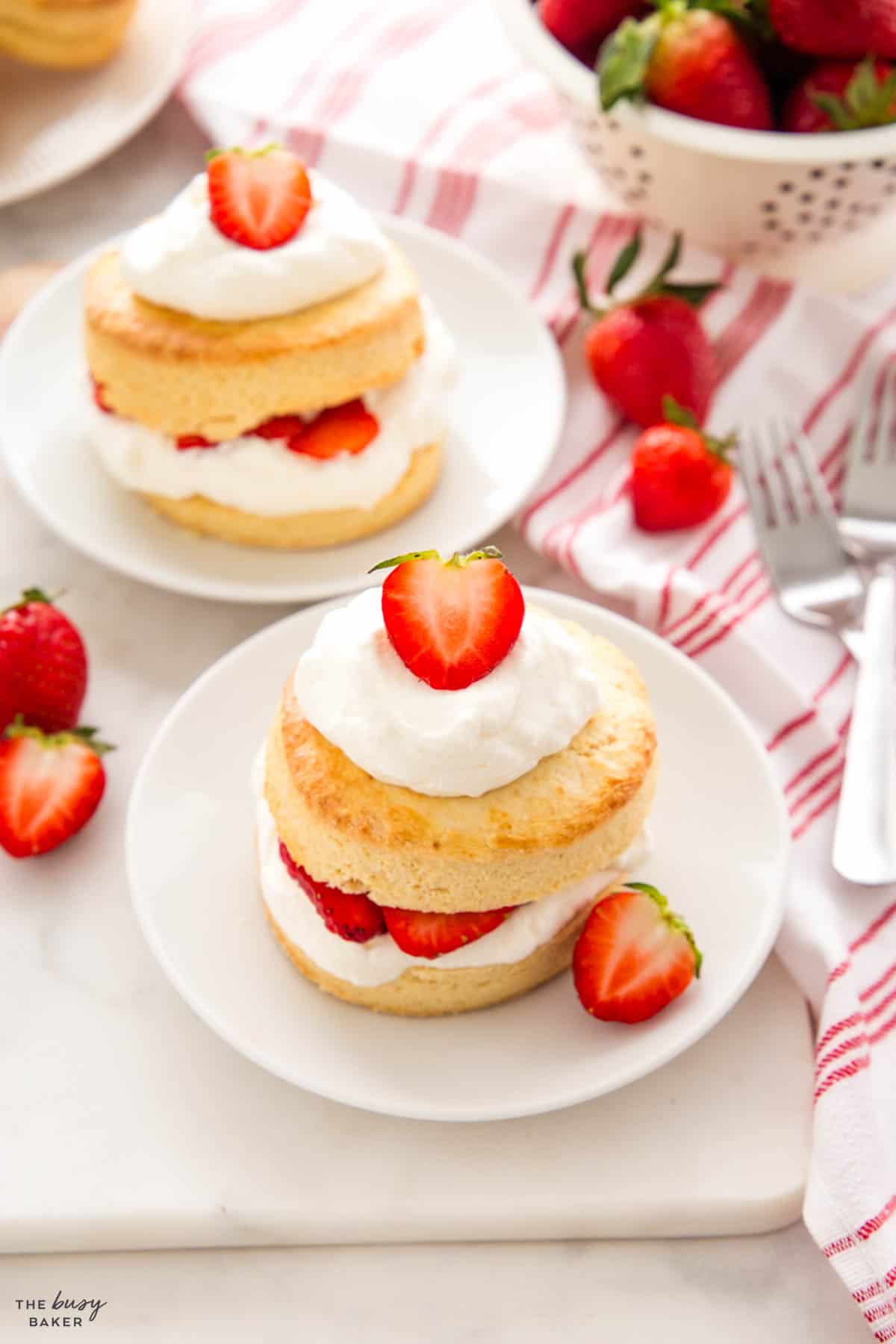
We hope you love this classic strawberry shortcake recipe as much as we do! Let us know, what’s your favourite simple dessert to make at home? We’d love to know!
- Easy Carrot Cake
- New York Cheesecake
- Tarte Tatin
- Best Red Velvet Cake
- Blueberry Pie
- Easy Pumpkin Cake
- Grasshopper Pie
- Angel Food Cake
- Strawberry Rhubarb Crisp
- Berry Chantilly Cake
If you made this, share a photo!
Are you trying this recipe? Use the comment form below to share your take; now with support for image uploads and comment voting!
Strawberry Shortcake

Recipe: Equipment
Recipe: Ingredients
For the Shortcakes
- 3 cups all purpose flour
- 1/3 cup granulated sugar
- 1 tablespoon baking powder
- 1/4 teaspoon salt
- 1/2 lemon zest only
- 3/4 cup half and half cream plus a few extra tablespoons for brushing on the shortcakes before baking
- 1 large egg
- 1 teaspoon vanilla
- 1/2 cup unsalted butter cold from the fridge
For the Strawberries
- 4 cups fresh strawberries sliced
- 4 tablespoons granulated sugar
For the Whipped Cream
- 2 cups heavy whipping cream
- 2 tablespoons granulated sugar
Recipe: Instructions
For the Shortcakes
- Preheat your oven to 375 degrees Fahrenheit and prepare a baking sheet or two (depending on how large your baking sheets are) by lining them with parchment paper. Set aside.
- In a large bowl combine the flour, sugar, baking powder, salt, and lemon zest. Mix well with a fork or a whisk.
- In a liquid measuring cup, measure the cream and add the egg and vanilla. Whisk together using a fork and set aside.
- The next few steps should be done quickly, as you're working with cold butter and you want the butter to be as cold as possible when it hits the heat of the oven. This will result in a soft and flaky shortcake.
- Cut up your butter, right from the fridge, into little pieces and dump it into the flour mixture. Using your hands (wash them well first and remove any rings), pick up handfuls of the butter and flour mixture, rubbing the pieces of butter and the flour between the heels of your hands to create "sheets" of butter. You should act quickly here and not allow the pieces of butter to sit in your hands for any length of time as the heat from your hands will cause it to soften. The goal is to create paper-thin pieces of butter, small and large throughout the mixture. Once there are no thick chunks of butter remaining, only thin sheets, remove your hands from the mixture. Hands equal heat, so handle the mixture as little as possible.
- Pour in the wet ingredients and mix roughly with a fork. Do not over mix or the result will be heavy and dense.
- Once the wet ingredients have been incorporated but there are still several streaks of flour, turn the dough out onto a clean and floured counter surface. Press the dough down into the counter and then fold one half over the other half like you are folding a piece of paper. Press down again and make another fold. Repeat this 2 or 3 more times, gathering any outlying dough bits and flour into your folds. Don't knead the dough like you would if you were making bread and don't stir or mix the dough like you would if you were making muffins. Shortcakes are technically a pastry, so the goal is flaky layers that are created by the thin sheets of butter and all the folding.
- Once your dough is formed after folding several times, shape it into a rectangle about 1 3/4 to 2 inches thick (approximately). Again, be careful not to handle the dough too much, so a few little cracks here and there are fine.
- Cut out circles of dough using a biscuit cutter or a sharp-edged rim of a glass or jar. Arrange the circles of dough on the parchment-lined baking sheet and brush the tops with a little bit of half and half cream.
- You'll need to re-shape the leftover dough to form another rectangle – do this carefully and gently, without adding much extra flour if possible. The less you handle the dough, the more tender and flaky the shortcakes will be. Cut out the remainder of the shortcakes until you have 8 in total.
- Bake for about 18-22 minutes just until barely golden brown and the surface of the shortcakes lose their shine. Let them cool for 3-5 minutes on the baking sheet. Transfer them to a cooling rack to cool completely.
For the Strawberries and Cream
- While the shortcakes are baking, add the sliced strawberries to a bowl and stir them together with the sugar. This will cause the strawberries to release moisture and create a sweet sauce.
- Whip the cream in the bowl of your stand mixer fitted with the whisk attachment or use a hand mixer and a mixing bowl. Add the sugar slowly when the cream begins to foam. Whip until the cream forms stiff peaks.
To Serve
- Once the shortcakes are baked and cooled, slice them in half and place a large dollop of cream between the layers, along with a spoonful of the strawberries and sauce.
- Add the top of the shortcake on top and add another dollop of cream and more strawberries.
- Serve immediately.
Recipe: Notes
Make-Ahead Instructions
To make this recipe ahead of time, simply bake the shortcakes and store them in an airtight container at room temperature until ready to serve. We recommend serving them within 24 hours of baking for best results.Storage Instructions
Store the shortcakes in an airtight container at room temperature for up to 3 days.Freezer Instructions
Freeze the shortcakes in an airtight container for several months. Defrost at room temperature.Recipe: Nutrition
Notice: Nutrition is auto-calculated, using Spoonacular, for your convenience. Where relevant, we recommend using your own nutrition calculations.
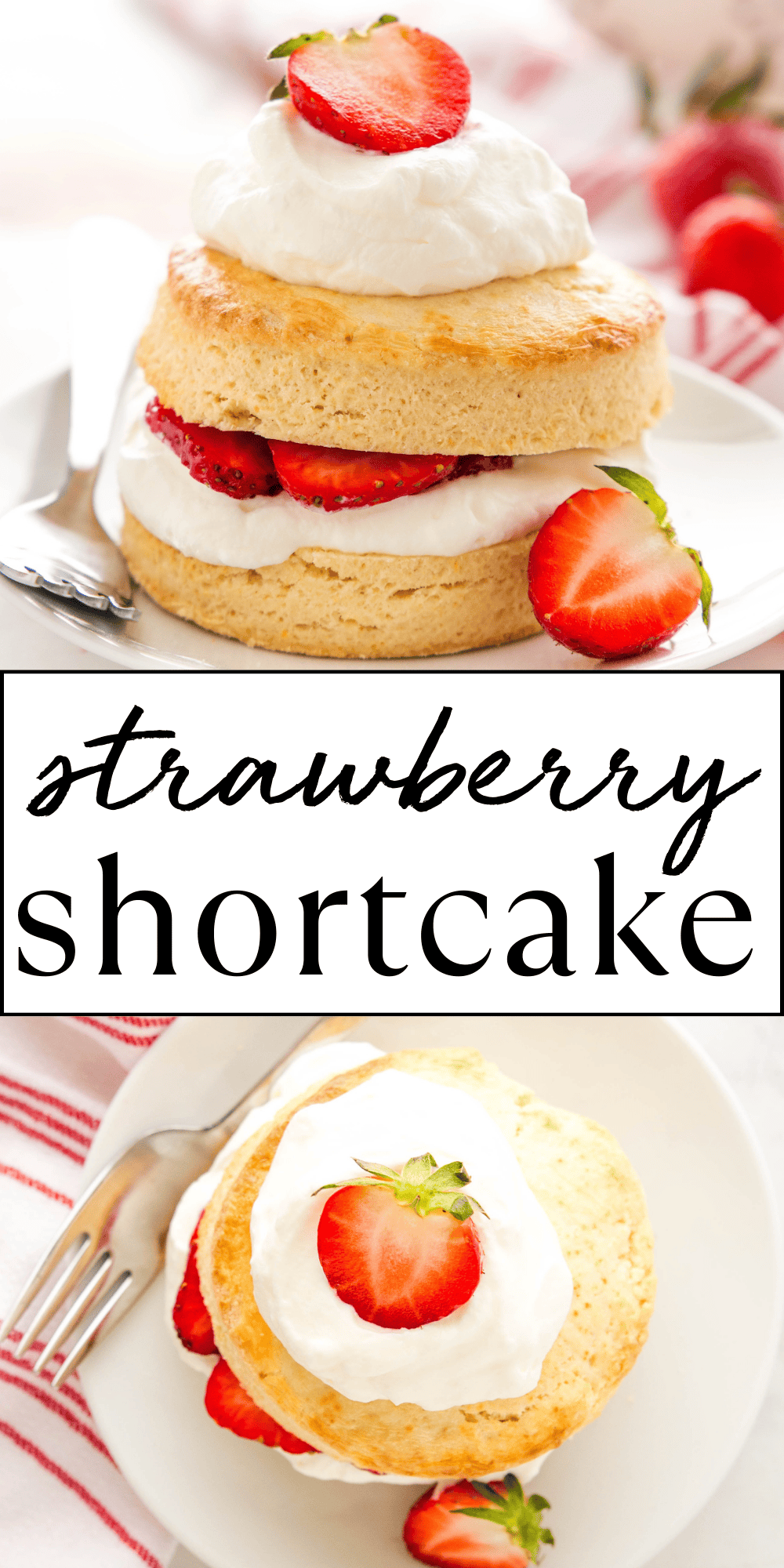

I am going to try these but need to buy a biscuit cutter. Do they come in a standard diameter or should I purchase a specific size for these?
We use this set https://amzn.to/4atacbF (affiliate link) and usually use the 3.5 inch or the 3.2 inch ones. Hope this helps!